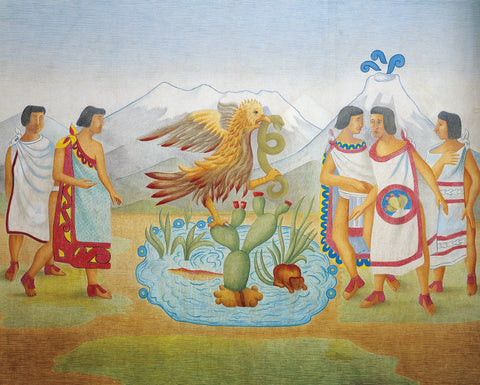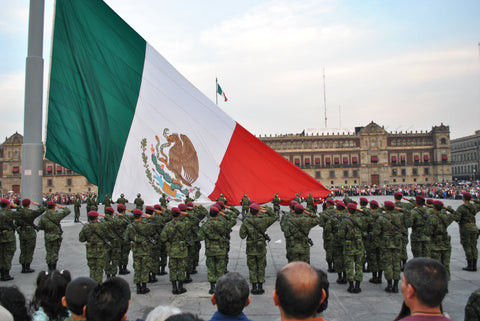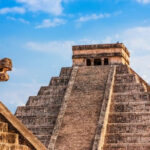The emblem on the Mexican flag, featuring an eagle devouring a snake, represents the foundation of Tenochtitlán, now Mexico City, and symbolizes strength, war, and bravery. At gaymexico.net, we understand the importance of cultural symbols and their significance, especially within the LGBTQ+ community as we explore the rich tapestry of Mexican heritage. Discover the stories and meanings behind this iconic image while planning your next trip to a welcoming and vibrant Mexico! Explore with us the vibrant culture and traditions of Mexico, from the stunning beaches of Puerto Vallarta to the historical landmarks of Mexico City.
1. What is the origin of the Mexican flag’s emblem?
The origin of the Mexican flag’s emblem lies in the Aztec legend of Tenochtitlán’s founding, symbolizing a new beginning, courage, and the divine mandate to build a great civilization. According to Mexica mythology, the god Huitzilopochtli ordered their people to establish their kingdom where they found “an eagle standing on a nopal devouring a snake.” This striking image embodies the Aztec’s arduous journey from Aztlán to the Valley of Mexico, where they encountered the prophesied sign on a small island in Lake Texcoco. This vision led to the establishment of Tenochtitlán, which later became Mexico City, the heart of Mexican identity.
1.1 What is Aztlán?
Aztlán, meaning “land of the herons,” is the mythical homeland of the Aztec people, believed to be located north of Tenochtitlán. While its exact geographical location remains debated among historians and archaeologists, Aztlán holds immense cultural significance as the ancestral origin of the Mexica people and a symbol of their spiritual and national unity. In modern Chicano culture, Aztlán represents a powerful symbol of identity, heritage, and resilience, particularly for those with roots in the territories ceded to the United States by Mexico in 1848.
1.2 How does the legend of Tenochtitlán connect to Mexican identity?
The legend of Tenochtitlán is deeply woven into the fabric of Mexican identity, symbolizing resilience, divine guidance, and the forging of a nation from diverse roots. The image of the eagle devouring the snake is not merely a historical anecdote; it represents the Mexican people’s ability to overcome challenges and build a thriving society. This legend reinforces a sense of national pride, unity, and connection to a rich indigenous heritage, serving as a constant reminder of Mexico’s unique history and cultural strength. This origin story provides an excellent springboard for exploring the country’s modern identity, especially its embrace of diversity as reported in publications like those of UCLA’s Williams Institute which highlight the LGBTQ+ community within Mexico.
 Aztlán is believed to be located north of Tenochtitlán, meaning "land of the herons."
Aztlán is believed to be located north of Tenochtitlán, meaning "land of the herons."
2. What are the elements of the Mexican coat of arms, and what do they represent?
The Mexican coat of arms features a majestic golden eagle perched on a prickly pear cactus, devouring a serpent, surrounded by oak and laurel branches, tied together by a ribbon in the national colors. Each element is rich with symbolism, representing the historical, cultural, and spiritual foundations of Mexico.
2.1 What does the golden eagle symbolize?
The golden eagle symbolizes strength, courage, and the warrior spirit of the Mexican people. It represents the nation’s ability to rise above adversity and combat challenges with unwavering determination. The eagle’s connection to the sun further reinforces its symbolic power, representing enlightenment and divine favor. The eagle is a reflection of the talent behind Mexican creators to give symbolism and meaning to every detail.
2.2 What is the significance of the snake?
The snake represents the challenges and enemies that Mexico has overcome throughout its history. Its depiction as being devoured by the eagle symbolizes the triumph of good over evil, and the Mexican people’s resilience in the face of adversity. This imagery reinforces a narrative of strength and perseverance, inspiring a sense of national pride and unity.
2.3 What do the nopal cactus, oak, and laurel branches represent?
The nopal cactus, or prickly pear, symbolizes the heart of the defeated warriors, representing the challenges and sacrifices endured in the pursuit of freedom and independence. The oak and laurel branches are badges of strength and victory, respectively, commemorating the heroes who contributed to the creation and defense of Mexico. These elements together represent the nation’s rich history, resilience, and the sacrifices made in the name of liberty.
2.4 What does the ribbon signify?
The ribbon, adorned with the national colors of green, white, and red, represents the unity of the Mexican people and their dedication to the homeland. It binds together the oak and laurel branches, symbolizing the interconnectedness of strength and victory in the nation’s journey. This ribbon serves as a reminder of the importance of national solidarity and the collective effort required to achieve common goals.
 The golden eagle symbolizes strength, courage, and the warrior spirit of the Mexican people.
The golden eagle symbolizes strength, courage, and the warrior spirit of the Mexican people.
3. What is the meaning behind the colors of the Mexican flag?
The colors of the Mexican flag—green, white, and red—each hold profound symbolic meaning, representing hope, unity, and the blood of national heroes, respectively. These colors have evolved in meaning over time, but their significance as core elements of Mexican identity has remained constant.
3.1 How has the meaning of the colors evolved?
The original meanings of the colors, adopted in 1821, were different from their current interpretations. Green represented independence, white symbolized religion, and red stood for the union between Europeans and Americans. However, under President Benito Juárez, the meanings were secularized to represent hope, unity, and the blood of national heroes, aligning with the liberal ideals of the time. This evolution reflects the changing political and social landscape of Mexico.
3.2 What does the green color symbolize today?
Today, green symbolizes hope and optimism for the future of Mexico. It represents the nation’s aspirations for progress, prosperity, and a brighter tomorrow. This color serves as a reminder of the country’s potential and the collective determination of its people to build a better society.
3.3 What does the white color represent?
White represents unity and peace among the Mexican people. It symbolizes the desire for harmony, cooperation, and social cohesion within the nation. This color promotes the idea of a unified Mexico, where diverse communities come together to build a strong and inclusive society.
3.4 What does the red color stand for?
Red represents the blood of the national heroes who sacrificed their lives for Mexico’s independence and freedom. It serves as a tribute to their courage, patriotism, and the ultimate sacrifice they made for the nation’s cause. This color is a poignant reminder of the price of liberty and the importance of honoring the sacrifices of those who fought for it.
4. How many times has the Mexican flag changed throughout history?
The Mexican flag has evolved thirteen times throughout its history, reflecting the nation’s changing political landscape and evolving identity. Each iteration has incorporated different symbols, designs, and color arrangements, while maintaining the core elements that represent Mexican heritage.
4.1 What are some of the notable changes in the flag’s design?
Some notable changes include the adoption of the Virgin de Guadalupe banner by Miguel Hidalgo during the Grito de Independencia, the addition of a crown to the eagle during the First Mexican Empire, and the standardization of the current design in 1968. Each modification reflects significant moments in Mexican history and the nation’s ongoing quest for self-definition.
4.2 When was the current flag officially adopted?
The current flag was officially adopted in 1968, but its general design has been in use since 1821 when the First National Flag was created. This design features the iconic emblem of the eagle devouring a snake, which has become synonymous with Mexican identity and national pride. The standardization of the flag in 1968 solidified its role as a unifying symbol for the Mexican people.
4.3 How does the flag reflect Mexico’s history and values?
The flag serves as a visual representation of Mexico’s complex history, rich cultural heritage, and core values. Its colors, emblem, and design elements embody the nation’s journey from ancient civilizations to modern independence, reflecting the struggles, triumphs, and aspirations of the Mexican people. The flag is a powerful symbol of national identity, inspiring a sense of unity, pride, and belonging.
 The Mexican flag serves as a visual representation of Mexico's complex history, rich cultural heritage, and core values.
The Mexican flag serves as a visual representation of Mexico's complex history, rich cultural heritage, and core values.
5. What is Día de la Bandera, and how is it celebrated in Mexico?
Día de la Bandera, or National Flag Day, is celebrated every February 24th in Mexico, commemorating the patriotic symbols that represent the nation’s identity, history, and values. This day is marked by official ceremonies, military parades, and school events that honor the Mexican flag and its significance.
5.1 What is the significance of Día de la Bandera?
Día de la Bandera is a day to honor the Mexican flag as a symbol of freedom, justice, and national pride. It provides an opportunity for Mexicans to reflect on their shared history, cultural heritage, and the values that unite them as a nation. This day reinforces a sense of national identity and promotes patriotism among citizens of all ages.
5.2 How is Día de la Bandera celebrated in Mexico?
Celebrations include official ceremonies at the National Palace of Mexico, where a military parade is held in the presence of the President. Schools across the country commemorate the events that occurred during the declaration of Independence of Mexico, with performances and plays that display battles and historic events. These celebrations aim to educate and inspire young Mexicans, fostering a sense of national pride and civic responsibility.
5.3 Is Día de la Bandera a federal holiday?
Although not as prominent as Independence Day on September 16th, Día de la Bandera is considered a federal holiday in Mexico. This means that government offices and schools are typically closed, allowing citizens to participate in the day’s celebrations and activities. The holiday provides an opportunity for communities to come together and honor the symbols that represent their shared identity.
6. How does the Mexican flag resonate with the LGBTQ+ community?
The Mexican flag, as a symbol of national identity, resonates with the LGBTQ+ community by representing inclusion, diversity, and the ongoing struggle for equality. For many LGBTQ+ individuals, the flag embodies the hope for a more inclusive and accepting Mexico, where their rights and identities are recognized and respected.
6.1 What are LGBTQ+ travelers seeking in Mexico?
LGBTQ+ travelers seek safe, welcoming, and inclusive environments where they can freely express themselves and enjoy their vacations without fear of discrimination or harassment. They look for destinations with established LGBTQ+ scenes, supportive local communities, and businesses that cater to their specific needs and interests. According to research from the UCLA Williams Institute, LGBTQ+ tourism contributes significantly to the economies of destinations that actively promote inclusivity and diversity.
6.2 How can LGBTQ+ travelers find welcoming destinations in Mexico?
LGBTQ+ travelers can find welcoming destinations in Mexico by researching cities and regions with strong LGBTQ+ communities, such as Puerto Vallarta, Mexico City, and Cancun. Online resources, travel guides, and LGBTQ+-specific travel agencies can provide valuable information on accommodations, attractions, and events that cater to LGBTQ+ travelers. Engaging with local LGBTQ+ organizations and community groups can also offer insights into the most welcoming and inclusive spaces.
6.3 What resources are available for LGBTQ+ individuals interested in Mexican culture?
Resources available for LGBTQ+ individuals interested in Mexican culture include LGBTQ+ community centers, cultural organizations, and online platforms that promote LGBTQ+ visibility and inclusion. These resources provide opportunities for LGBTQ+ individuals to connect with their heritage, learn about Mexican history and traditions, and engage in cultural exchange. Websites like gaymexico.net serve as valuable platforms for sharing stories, resources, and information relevant to the LGBTQ+ community in Mexico.
7. What are some LGBTQ+-friendly destinations in Mexico?
Mexico boasts a variety of LGBTQ+-friendly destinations, each offering unique cultural experiences, vibrant nightlife, and welcoming communities. Some of the most popular destinations include Puerto Vallarta, Mexico City, and Cancun, all of which have well-established LGBTQ+ scenes and a reputation for inclusivity.
7.1 Why is Puerto Vallarta considered an LGBTQ+-friendly destination?
Puerto Vallarta is renowned as one of the most LGBTQ+-friendly destinations in Mexico, thanks to its thriving LGBTQ+ community, numerous gay bars and clubs, and a welcoming atmosphere that embraces diversity. The city hosts annual LGBTQ+ pride celebrations and events, attracting visitors from around the world. Puerto Vallarta’s commitment to inclusivity and its stunning natural beauty make it a popular choice for LGBTQ+ travelers.
7.2 What does Mexico City offer for LGBTQ+ travelers?
Mexico City offers a diverse and vibrant LGBTQ+ scene, with numerous gay bars, clubs, and cultural events throughout the city. The Zona Rosa neighborhood is particularly known for its LGBTQ+ nightlife and inclusive atmosphere. Mexico City’s rich history, world-class museums, and diverse culinary scene make it an attractive destination for LGBTQ+ travelers seeking a culturally enriching experience.
7.3 How is Cancun becoming more LGBTQ+-friendly?
Cancun is increasingly becoming an LGBTQ+-friendly destination, with a growing number of hotels, resorts, and businesses catering to LGBTQ+ travelers. While not as established as Puerto Vallarta or Mexico City, Cancun offers beautiful beaches, luxurious accommodations, and a range of activities that appeal to LGBTQ+ visitors. Efforts to promote inclusivity and diversity are helping to make Cancun a more welcoming destination for LGBTQ+ travelers.
8. How can gaymexico.net help LGBTQ+ individuals explore Mexico?
Gaymexico.net serves as a comprehensive resource for LGBTQ+ individuals planning to explore Mexico, offering valuable information, travel guides, and community connections. The website provides insights into LGBTQ+-friendly destinations, events, and businesses, empowering travelers to make informed decisions and enjoy safe, welcoming experiences.
8.1 What information does gaymexico.net provide for LGBTQ+ travelers?
Gaymexico.net provides a wealth of information for LGBTQ+ travelers, including destination guides, hotel and accommodation recommendations, LGBTQ+ event listings, and local community resources. The website also offers practical tips for traveling safely and respectfully in Mexico, ensuring that LGBTQ+ visitors have a positive and empowering experience.
8.2 How does gaymexico.net connect LGBTQ+ individuals with local communities?
Gaymexico.net connects LGBTQ+ individuals with local communities by providing listings of LGBTQ+ organizations, community centers, and support groups throughout Mexico. The website also features personal stories and testimonials from LGBTQ+ residents and travelers, offering valuable insights into the local culture and social landscape. By fostering connections between visitors and local communities, gaymexico.net promotes cultural exchange, understanding, and solidarity.
8.3 How can gaymexico.net enhance the travel experience for LGBTQ+ individuals?
Gaymexico.net enhances the travel experience for LGBTQ+ individuals by providing a trusted and reliable platform for accessing information, resources, and community connections. The website empowers LGBTQ+ travelers to plan their trips with confidence, knowing that they have access to the support and guidance they need to navigate Mexico safely and enjoyably. By promoting inclusivity, diversity, and cultural understanding, gaymexico.net helps create a more welcoming and empowering travel experience for LGBTQ+ individuals.
9. What are some challenges faced by the LGBTQ+ community in Mexico?
Despite progress in recent years, the LGBTQ+ community in Mexico continues to face challenges, including discrimination, violence, and legal inequalities. While same-sex marriage is legal in many parts of the country, societal attitudes and cultural norms can still pose significant barriers to full equality and inclusion.
9.1 What are some legal protections for LGBTQ+ individuals in Mexico?
Legal protections for LGBTQ+ individuals in Mexico vary by region, with some states and cities offering more comprehensive protections than others. Same-sex marriage is legal in a majority of Mexican states, and anti-discrimination laws exist in some jurisdictions. However, there is still a need for nationwide legislation to ensure consistent protection for LGBTQ+ individuals across the country.
9.2 How does societal attitudes impact the LGBTQ+ community in Mexico?
Societal attitudes towards the LGBTQ+ community in Mexico can range from acceptance and support to prejudice and discrimination. While there has been progress in promoting LGBTQ+ rights and visibility, traditional cultural norms and religious beliefs can still contribute to negative stereotypes and discriminatory practices. Addressing these societal attitudes requires ongoing education, advocacy, and cultural change.
9.3 What resources are available to support the LGBTQ+ community in Mexico?
Resources available to support the LGBTQ+ community in Mexico include LGBTQ+ organizations, community centers, and advocacy groups that provide services such as counseling, legal assistance, and safe spaces. These organizations work to promote LGBTQ+ rights, raise awareness about LGBTQ+ issues, and provide support for individuals facing discrimination or violence. Additionally, international human rights organizations like Human Rights Watch monitor the situation in Mexico and advocate for greater protections for LGBTQ+ individuals.
10. What is the future of LGBTQ+ rights and inclusion in Mexico?
The future of LGBTQ+ rights and inclusion in Mexico depends on continued progress in legal reforms, societal attitudes, and cultural representation. Ongoing efforts to promote equality, raise awareness, and challenge discrimination are essential for creating a more just and inclusive society for LGBTQ+ individuals in Mexico.
10.1 What legal reforms are needed to advance LGBTQ+ rights in Mexico?
Legal reforms needed to advance LGBTQ+ rights in Mexico include the legalization of same-sex marriage in all states, the enactment of comprehensive anti-discrimination laws, and the recognition of transgender individuals’ rights to legal gender recognition. These reforms would provide greater legal protections for LGBTQ+ individuals and help to ensure their equal treatment under the law.
10.2 How can societal attitudes be changed to promote greater inclusion?
Societal attitudes can be changed to promote greater inclusion through education, awareness campaigns, and cultural representation that challenge negative stereotypes and promote understanding and acceptance. Engaging with religious leaders, community leaders, and the media is crucial for fostering positive dialogue and promoting a more inclusive society. Additionally, supporting LGBTQ+ organizations and initiatives can help to raise visibility and create a more welcoming environment for LGBTQ+ individuals.
10.3 What role does the international community play in supporting LGBTQ+ rights in Mexico?
The international community plays a crucial role in supporting LGBTQ+ rights in Mexico by providing funding, technical assistance, and advocacy support to local organizations and initiatives. International human rights organizations monitor the situation in Mexico and advocate for greater protections for LGBTQ+ individuals, while diplomatic efforts can help to encourage the Mexican government to enact legal reforms and promote inclusivity. By working together, the international community and local stakeholders can help to advance LGBTQ+ rights and create a more just and equitable society in Mexico.
At gaymexico.net, we encourage you to explore the beauty and diversity of Mexico, while staying informed and respectful of local cultures and customs. Whether you’re seeking adventure, relaxation, or cultural immersion, Mexico offers a wealth of experiences for LGBTQ+ travelers. From the ancient ruins of Teotihuacan to the pristine beaches of the Riviera Maya, there’s something for everyone to enjoy in this vibrant and welcoming country.
Explore Mexico with confidence and pride, knowing that you’re part of a global community that values diversity and inclusion. Visit gaymexico.net today to discover LGBTQ+-friendly destinations, events, and resources, and start planning your unforgettable Mexican adventure!
Address: 3255 Wilshire Blvd, Los Angeles, CA 90010, United States
Phone: +1 (213) 380-2177
Website: gaymexico.net
FAQ Section
1. What is the significance of the eagle devouring a snake on the Mexican flag?
The eagle devouring a snake symbolizes the Aztec legend of Tenochtitlán’s founding, representing the triumph of good over evil and the strength of the Mexican people. This image represents the foundation of Tenochtitlán, now Mexico City, and symbolizes strength, war, and bravery.
2. What do the colors of the Mexican flag represent?
The colors of the Mexican flag represent hope (green), unity (white), and the blood of national heroes (red). These colors have evolved in meaning over time, but their significance as core elements of Mexican identity has remained constant.
3. How many times has the Mexican flag changed throughout history?
The Mexican flag has changed thirteen times throughout its history, reflecting the nation’s changing political landscape and evolving identity. Each iteration has incorporated different symbols, designs, and color arrangements, while maintaining the core elements that represent Mexican heritage.
4. Is Mexico safe for LGBTQ+ tourists?
Mexico has many destinations that are very safe for LGBTQ+ tourists. However, it is essential to research and choose locations known for their inclusivity. Websites like gaymexico.net can help you plan safe and enjoyable trips.
5. What cities in Mexico are most LGBTQ+-friendly?
Some of the most LGBTQ+-friendly cities in Mexico include Puerto Vallarta, Mexico City, and Cancun. These cities have vibrant LGBTQ+ scenes and offer a welcoming atmosphere for tourists.
6. What kind of LGBTQ+ events can I find in Mexico?
Mexico hosts various LGBTQ+ events, including pride festivals, cultural celebrations, and parties. Puerto Vallarta Pride is one of the most popular, attracting visitors from around the world.
7. Are same-sex marriages legal in Mexico?
Yes, same-sex marriage is legal in many parts of Mexico, but the laws can vary by state. It’s advisable to check the legal status in the specific region you plan to visit.
8. How can I find LGBTQ+-friendly accommodations in Mexico?
You can find LGBTQ+-friendly accommodations through websites like gaymexico.net, which offer listings of hotels, resorts, and guesthouses that cater to the LGBTQ+ community.
9. What resources are available for LGBTQ+ travelers in Mexico?
Resources include LGBTQ+ community centers, cultural organizations, and online platforms like gaymexico.net that provide information and support. These resources can assist with travel planning and provide insights into local LGBTQ+ communities.
10. What should LGBTQ+ travelers know about local customs in Mexico?
While many areas are very welcoming, it’s important to be aware of local customs and traditions. Showing respect for local culture and being mindful of public displays of affection can help ensure a positive experience.

